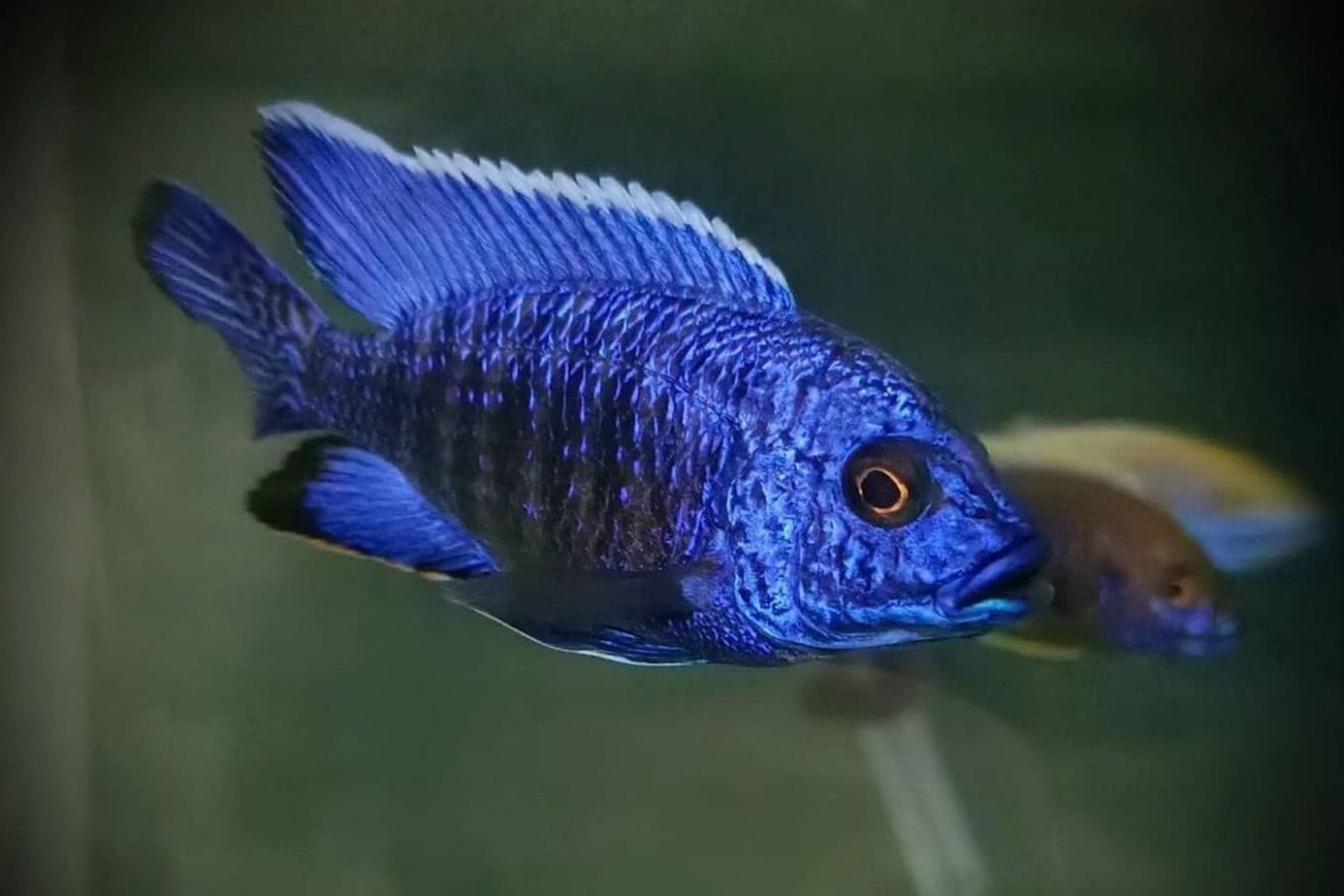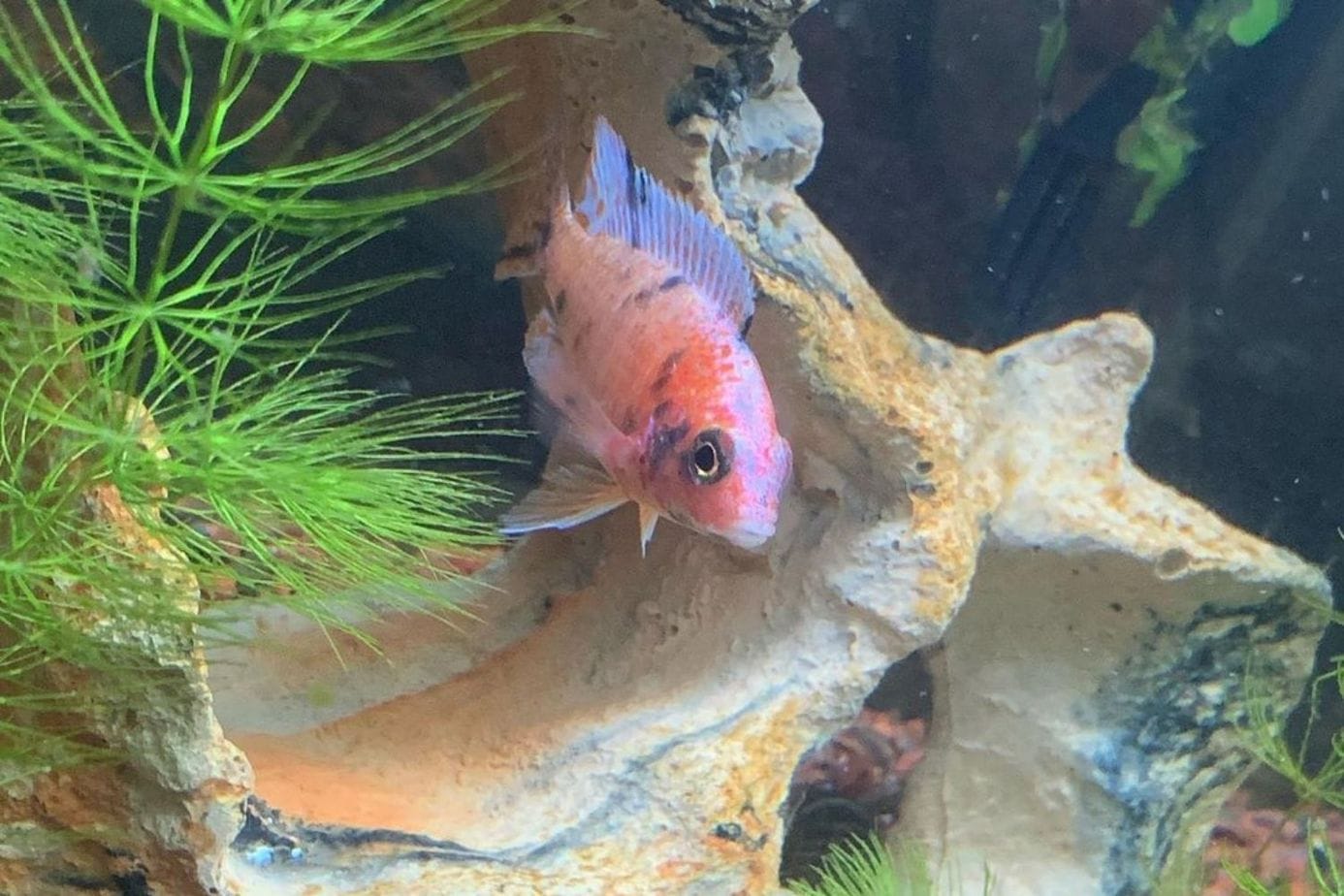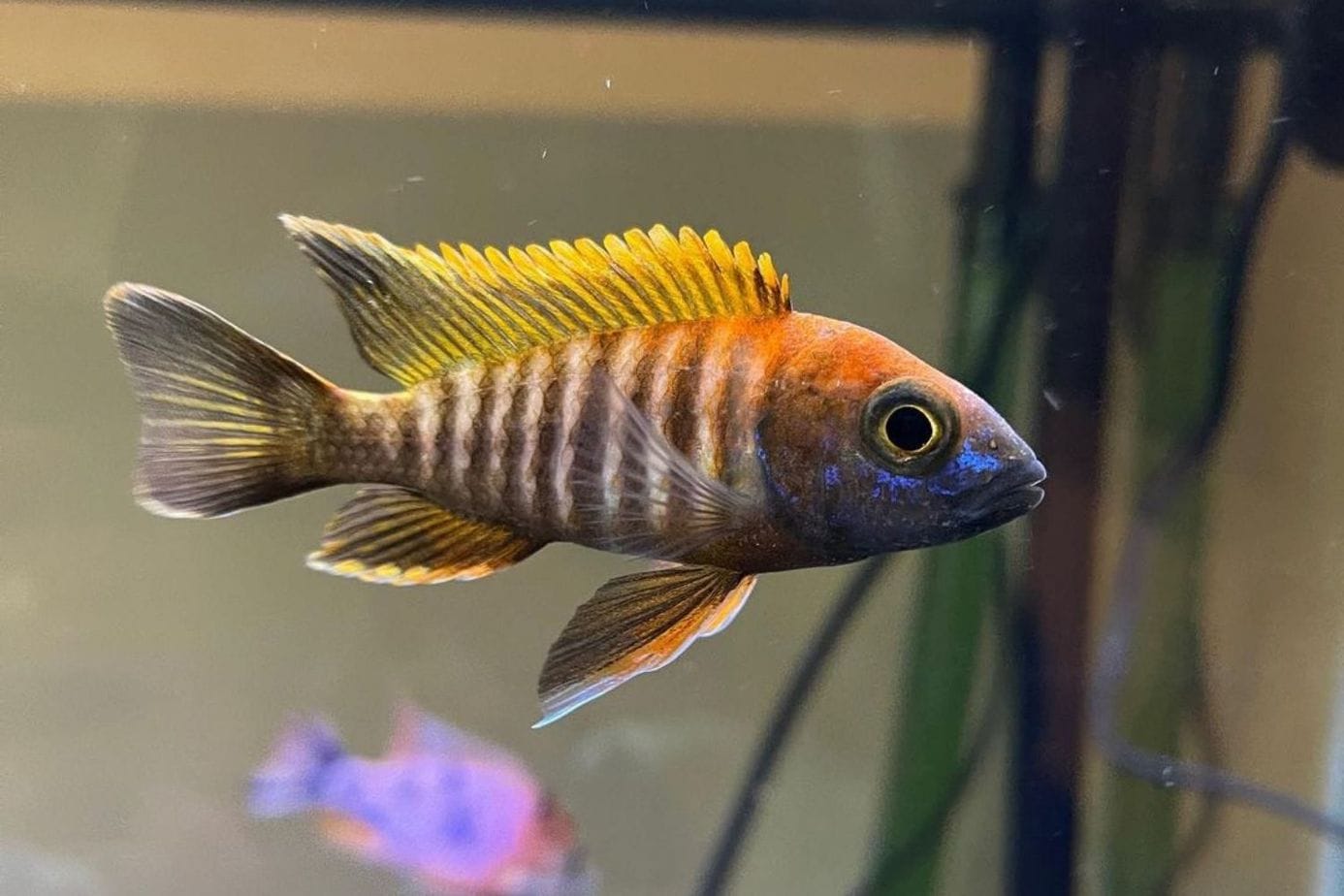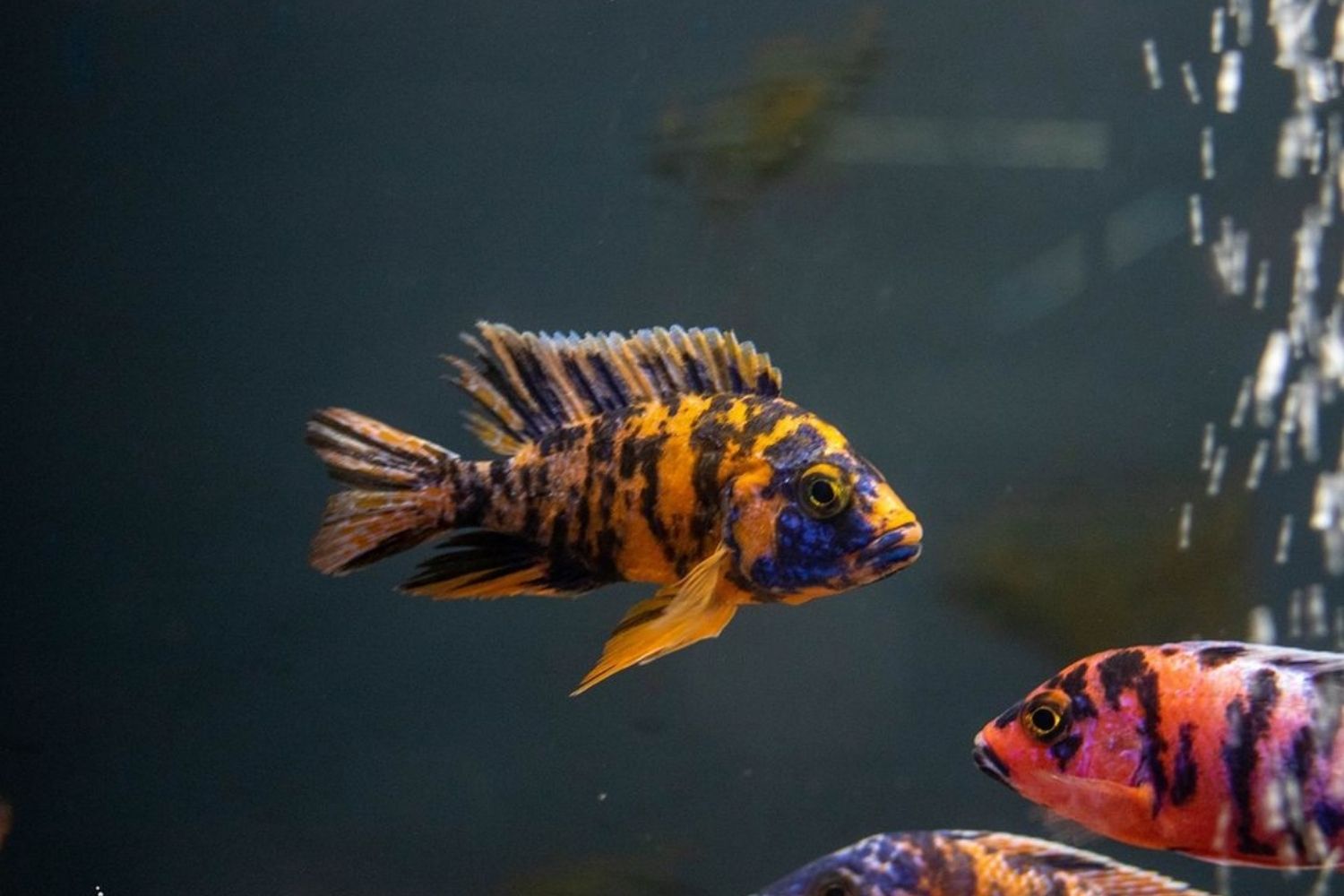Peacock Cichlids are part of the most colorful fish in the world that all aquarium enthusiasts would love to have. They are known to be the most friendly and peaceful members of the Cichlids, with an outstanding variety in coloration. There are a few essential parameters that you need to follow to keep this fish healthy. Otherwise, it will die. Our Care Guide will show you everything you need to know to keep him healthy. Not only that, we will show the variety of this species and their beauty.
Here you will get to learn everything you need to know about Peacock Cichlids. You will be able to learn more about the known varieties, how to take good care of them, which are the ideal tank mates, how to set up your tank, to breed them, and so much more. At the end of this article, you will feel confident enough to take care of your Peacock Cichlid.
Overview
The Peacock Cichlid is native to Lake Malawi, and there are more than 22 different types of Peacocks. Most of them have stunning coloration and are friendly compared to other cichlids. As we know, the majority of these species are known as aggressive. Still, this fish is more peaceful than Firemouth Cichlid, Flowerhorn Cichlid, Jack Dempsey Cichlid, Convict Cichlid, and even Red Devil Cichlid.

Peacock Cichlid can be found in different colors.
The Peacock Cichlid coloration varies from red and blue to yellow and will enchant any aquarium. The most popular Peacock cichlid is the blue variation known as Aulonocara Nyassae. You will notice that the coloration of this fish, instead of a matt color, is, in fact, iridescent. Their color is permanent and doesn’t depend on their mood and breeding status like other cichlids.
Even though in different varieties, the Peacock Cichlid is basically the same fish except in coloring; their color varies depending on the region that they come from. We should state that males are the ones with the most enhanced colors.
A Peacock Cichlid needs a minimum of a 55-gallon aquarium. Therefore, a 100 gallons tank is needed if you plan to maintain this fish in a community. Here are some of the essential requirements of this fish:
| Care difficulty | Easy |
| Temperament | Semi-aggressive |
| Color | Various, typically blue |
| Lifespan | 6 – 8 Years |
| Size | 4 inches -6 inches |
| Diet | Omnivore |
| Family | Chilidae |
| Tank size | 55 gallons minimum |
| Tank set-up | Freshwater, driftwood and caves |
| Compatibility | Mixed |
Behavior and Temperament
A common behavior that Peacock Cichlids will display is predatory. Just like Jaguar Cichlid, they will be hunting for food in the sand. They have a strategy of standing above the sand and waiting for the prey, in the moment that they notice any moves of any invertebrates, they will strike action. You will be able to notice their common behavior of sifting through the substrate.
In general, they are peaceful and can make good community fish, but males can be territorial, especially in the breeding period. They are active swimmers, although known as the most peaceful Cichlids available.
Size and Lifespan
The Peacock Cichlid will grow to around 6 inches long and generally has an oversized lateral line system. Their average lifespan is 6 to 8 years if keeping the proper conditions and maintain a healthy diet. This means if you check and maintain the proper water parameters and water quality and keep them with the proper diet, they will have a healthy and long life.
Peacock Cichlid Varieties
As we mentioned above, Peacock Cichlids have many different types based on their coloration. It would be excessive to list all the varieties of this species since they’re more than 22 of them. That is why we will share information about the most popular varieties.
Their stunning beauty is the reason why these varieties are so popular. Each variation of Peacock Cichlid has a distinct vibrant color that is unmatched by other freshwater fish.
Ob Peacock Cichlid
The Ob Peacock Cichlid is very popular, and we can say that it is our favorite. This fish has a particular red body with interesting dark blue patches all over it. The patches start to get brighter up to their face and go up to their caudal and dorsal fins.

Ob Peacock Cichlid has some of the most beautiful colors.
Ob Peacock Cichlid is hybrid and is between pure Peacock Cichlid breeds. OB Peacocks offer some unique colorations, but they are similar in size to regular Peacocks. They are all stunning in coloration, but the patches may be the ones that differentiate this fish from other varieties.
Strawberry Peacock Cichlid
The Strawberry Peacock Cichlid is another beautiful variety of Peacock Cichlids. They have a bright reddish pink that gives them the name ‘strawberry,’ and some even have interesting dots that cover their fins, referring to the strawberry seeds. It is very hard to find the true definition of strawberry in Peacock Cichlids, and this variety is a really lucky one to find.
Red Peacock Cichlid
Red Peacock Cichlid is definitely the most popular variety of this species, and there is no need to tell why. The bright red color of this fish stands out no matter what other fish shares the same tank. Except for their red coloration, they have a very interesting and unique fragment of blue sprinkled throughout their fins.

Red Peacock Cichlid combined with Ob Peacock Cichlid.
This variety of the Flavescent Peacock is very unique. It is actually a man-made creation. It does not occur in its natural habitat. This type has the same size as other Peacocks except for its red coloration. Don’t get confused if you want to purchase this type. They are also referred to as Ruby Red and Rubin Red.
Blue Peacock Cichlid
Blue Peacock Cichlid is the type of this species known for its blue color all over its body. It is characterized by darker vertical stripes that start at the front of the dorsal fin and continue up to the end of the caudal peduncle. Their vibrant coloration depends on the location that is found, the gender (males tend to have more enhanced colors), and age.

Blue Peacock Cichlid has a pure blue color.
It stands out for its metallic blue, which fades to a bright yellow. During the breeding season, the colors will enhance and give more color to your tank. Its female counterpart has a gray color like all other types of Peacock, so if you want a great colorization of this type, choose a male.
Diet and Feeding
Peacock Cichlids eat both meat and plants. They’re omnivores. In the wild, they will sift through the sandy substrates hunting or picking up food, meaning that they are bottom dwellers. They will typically eat insects, larvae, zooplankton, and other crustaceans. That is why you should try to emulate them inside your aquarium.
For proper feeding, make sure you choose the best cichlid foods at the core of your diet. You can then mix them with other meat and vegetables. As for feeding frequency, you should feed them several smaller portions throughout the day. This will also help to maintain the water chemistry.
For meat and general food, it is suggested to use:
- Brine Shrimp (no matter live or frozen),
- Daphnia frozen,
- Granules,
- Cichlid flakes,
- Insects, etc.
Foods to avoid: tubifex worms and all mammal meat because they can cause Malawi bloat.
Peacock Cichlid Care & Tank Requirements
Peacock Cichlid care is something that you won’t have any trouble with, no matter if you are a beginner or an experienced aquarist. In general, they require low maintenance, and you can put less effort in compared with most fish. However, they can be sensitive to drastic changes in their environment. That’s why you should pay attention to their essential care requirements and keep them as consistent as possible.

Peacock Cichlid likes to hide on rocks or aquatic plants.
Remember that Peacock Cichlids, as we said earlier, hunt for food near the bottom of the tank, so never use gravel for the substrate to avoid damage to the fish’s gills. A soft and sandy substrate is going to be better in the long term for your fish to grow happy and healthy. Make sure to provide rocks and driftwood to serve as caves to hide and minimize territorial issues since they need space. Having different plants like Bacopa Caroliniana can create some extra spaces for this fish to hide.
Feel free to add plants for decoration if you want to. When choosing plants, we also suggest:
- Christmas Moss
- Red Root Floater
- Duckweed
- Amazon Frogbit
- Bacopa Caroliniana
- Dwarf Water Lettuce
With these plants, the disturbances to the substrate won’t be an issue. Peacock Cichlids will avoid eating aquarium plants. They just like to dig.
Tank Size
The recommended tank size for Peacock Cichlid is a minimum of 55-60 gallons. The size is very important because these fish are active swimmers and hunters. This would also give them their space since they tend to be territorial. A larger tank would be a perfect choice as it would match with their wild habitat. If you are thinking about keeping a large community of this fish, a minimum 100 gallons sized tank is suggested because they tend to be territorial and protect their space.
Water Parameters
Peacock Cichlids will thrive when meeting a water environment that has similar conditions to their native habitat. Although their water is warmer than the water habitat of other cichlid species. The water should be consistent year-round when talking about parameters and water chemistry.
The water temperature should range from 74°F to 82°F, pH levels of 7.5 to 8.5, and hardness of 4 to 6 dH. It is important for this fish to maintain these parameters consistently and not meet drastic changes. Another important thing that you should pay attention to is to keep the water as clean as possible. Peacock Cichlids live in very clear waters in their natural habitat. They will not grow healthy enough if you don’t check and maintain the water quality.
Breeding
When talking about breeding, the male Peacock Cichlid tend to have a solitary life and will need space if sharing their tank with other males. In the breeding period, they become polygamous and will play the field any chance they get. That is why they need space in order to avoid conflicts with other males.

You can breed Blue Peacock Cichlid and it can result in new color species.
To choose this problem, it is important to keep only one male in the breeding tank. This ratio is perfect because it will avoid fighting for their or even claiming others’ territory.
A great tip that would favor breeding this fish is to raise the water temperature to the upper limits of their normal range. This change of temperature should be done gradually since the fish is sensitive to drastic changes.
When the male feels ready, he will start to do a typical mating dance or movement pattern to attract the female. If the male is successful with the female, she will lay her eggs near his cave. This is another reason why males need their space to make the fertilization process and not risk the safety of eggs when sharing the same tank with other males.
As we know, these fish are mouthbrooders, which means that the female will collect the fertilized eggs in her mouth. After this, she will go to the cave to incubate the eggs. If you see this happening, don’t panic, she will not eat the eggs. It’s just part of the breeding process. The incubation process will take up to 28 days, and when the process is finished, you’ll see between 12-50 fries in your tank.
Sex Difference
When sex differencing Peacock Cichlids, it is important to make sure they are one brood. If yes, you can simply go by size; the larger fish are males, even at an inch or less. At 1.5 to 2 inches, an especially blue color should start showing up. As we know, males have an enhanced coloration compared to females.
Diseases
The Malawi bloat is a fatal disease that risks Peacock Cichlids, similar to dropsy, and results from overeating meaty foods. The symptoms include: abdominal inflammation, lack of appetite, labored respiration, and swimming at the bottom of the tank. The cases of this disease will result in harm to the liver, kidney, and swim bladder until the death of the fish within 1 to 3 days.
Swim bladder disease is another issue caused by a poor diet. This problem is a result of intestinal gas or parasites that end up infecting the swim bladder. The symptoms of this disease are: floating at the top of the tank and being unable to pick up food by remaining near the bottom. To prevent this, it is important to feed your Peacock Cichlid plenty of protein or dried food and add fiber such as vegetables.
Being overweight is another problem for Peacock cichlids as they can lose their beautiful coloration and even die prematurely. That is why you should not overfeed them. Another disease that infects cichlids is fish tuberculosis. It is highly infectious and can wipe out an entire tank population within a short period. Symptoms include frayed fins, lack of appetite, a sunken abdomen, and white blotches. If you think one fish is infected, immediately remove all other fish from a new tank. Treat the new tank with an antibiotic and disinfect the old tank or either get rid of it.
Tank Mates
Cichlids, in general, have a bad reputation for their aggressive temperament, although they deserve it. Luckily, Peacock Cichlids are more peaceful and friendlier than other Cichlids members and usually go well with a variety of fish.
The most aggressive Cichlid fish is Wolf Cichlid.
When choosing the proper tankmates, you should make sure that other fish will survive in the same water conditions as Peacock Cichlids. This is why the ideal tankmates for this fish are also native to their habitat, especially the Lake Malawi regions.

Peacock Cichlid can peacefully live in a community.
More gentle Haplochromis can happily share the tank with your Peacocks, for example:
- Copadichromis
- Placidochromis
- Nyassachromis
- Sciaenochromis
However, other more active fish that are also native to these regions should be avoided to maintain in the same tank. Some of them are Petrotilapia, Labeotropheus, Pseudotropheus, and Mbuna.

That’s our aquarium. We love to keep Peacock Cichlid in our tank.

